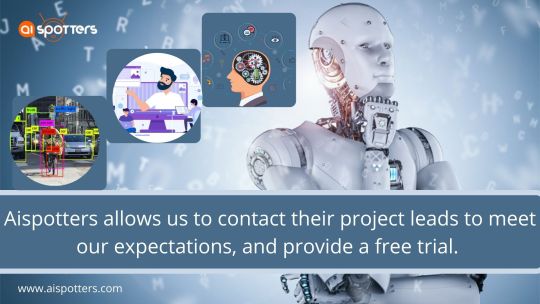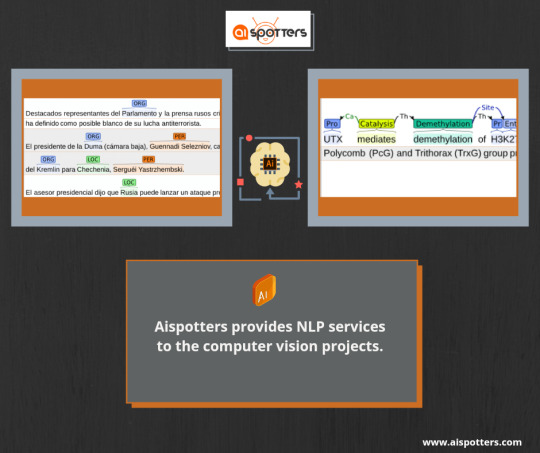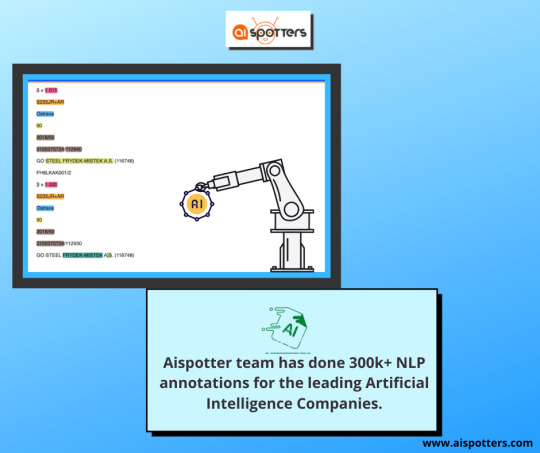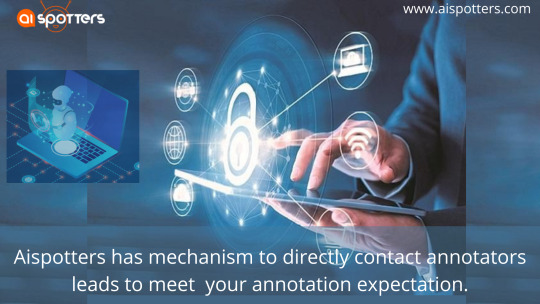#VideoAnnotation
Explore tagged Tumblr posts
Text
What are the types of data annotation?
Choosing the right type of data annotation is essential for the success of any AI project. It not only improves the accuracy of machine learning models but also enhances the overall efficiency and reliability of the system. EnFuse Solutions stands out as the best data annotation service provider in India. Whether text, image, video, audio, or 3D data annotation, EnFuse Solutions delivers top-notch services to meet specific project needs.
#DataAnnotation#TypesOfDataAnnotation#DataLabeling#AIDataAnnotation#MLDataAnnotation#ImageAnnotation#TextAnnotation#VideoAnnotation#AudioAnnotation#SemanticAnnotation#BoundingBoxAnnotation#PolygonAnnotation#DataTagging#AnnotationForAI#AnnotationForML#TrainingDataAnnotation#DataAnnotationServices#AIAnnotationServices#DataAnnotationIndia#EnFuseAIAnnotation#EnFuseDataAnnotation#EnFuseSolutions
0 notes
Text
Video Annotation: Empowering AI with Actionable Visual Data

It is the known truth that AI thrives on data, and with computer vision, video data assumes center stage. But just any raw video footage is not what you want for training machine learning models involving recognition of intricate visual environments. This is where video annotation slowly comes into play-dictating the means of converting unstructured video content into actionable labeled data that completes the loop of AI-based applications.
From self-driving cars to surveillance systems, video annotation provides that all support to enable AI models to understand dynamic environments. In this article, we'll explore what video annotation is about, its process, challenges, and how it can change the AI landscape.
What is Video Annotation?
Video annotation is the method of tagging a video with meaningful metadata that lets machine learning models identify, predict, and even recognize objects, motions, or activities taking place in the video. This process allows AI systems to use video data within a real-life context when making interpretations.
Depending on the sophistication of the task, annotated videos may come in different forms, such as bounding boxes, polygons, key points, or semantic segmentation. These labels provide the AI with structured information that lets it learn how objects are spatially related, their trajectories, and the evolution of temporal relationships among video frames.
The Importance of Video Annotation in AI
Video annotation is vital for building a bridge between one piece of video footage and functional AI models. Here is why it is a necessary:
Enabling Object Detection and Tracking: Through annotated video data, AI models can actually identify and trace objects across different frames. Such ability is critical when creating and implementing such systems as self-driving cars, where the system should be able to observe a moving object such as a pedestrian, vehicles, and road signs all at once.
Improved Action Recognition: AI systems trained with annotated video data could identify and categorize every human activity. This opens new avenues for sports analysis, security, and even healthcare in areas like fall detection for elderly persons.
Enhanced Predictive Capabilities: Annotations assist the models in learning temporal sequences that can help in inferring events based on observed trends. In traffic monitoring, AI predicts congestion trends and alerts highway patrol officers of incidents.
Supporting Real-Time Decision Making: Annotation in video data ensures an AI decision-making capability in real-time with scenarios built around drone piloting or robotic surgery, and in turn lessens the risk considerably.
Video Annotation Techniques
How videos are annotated is determined by the needs of the AI model and the complexity of visual data being considered. Some standard techniques include:
Bounding Boxes: Bounding boxes are used to mark out objects in the video. They give a rectangular boundary to the object, which works best for applications like detection and tracking of the object.
Polygon Annotation: For a more irregular shape of the object, polygon provides a more accurate boundary. This helps greatly in detecting complex shapes or crowded scenes.
Key Point Annotation: Key points are specific features such as facial landmarks, joint positions, or edges of the object to be tracked. This is very useful in pose estimation and activity recognition.
Semantic Segmentation: In this, every pixel in a frame of the video is assigned a class label, giving detailed context for activities such as mobile navigation and environment mapping.
3D Cuboids: Cuboids extend the annotation in three dimensions, thus allowing AI systems to view depth and understand 3D spatial relations.
Challenges of Video Annotation
Despite being critical, video annotation presents peculiar challenges:
High Resource Demand: Annotating video data is exhausting and resource-intensive, considering that every frame needs to be labeled. With most sophisticated AI models needing, by and large, a few thousand hours of footage to be annotated.
Ensuring Consistency: Consistency across annotations is vital for avoiding confusion for the model. Variation in labeling guidelines or human error may create a negative impact on model accuracy.
Dealing with Complexity: Occlusions, low lights, and cluttered environments exist in whatever video data come from the real world to contribute further challenges to the final quality of annotation.
Privacy Concerns: When dealing with sensitive video material like surveillance or medical footage, it is important to follow laws of data protection and privacy for the annotation process.
Best Practices for Effective Video Annotation
With great anticipation, these best practices should be followed by organizations, helping overcome those challenges and lead to a final high-quality annotated output:
Develop Clear Guidelines: Consistency starts with a well-defined set of instructions for annotators. This minimizes ambiguity and improves accuracy.
Leverage Automation: Use AI-powered annotation tools to automate repetitive tasks, such as object tracking, thus lessening the burden placed on human annotators.
Train Annotators: Good annotators are crucial in helping to tackle the complexities offered, ensuring that their job is aligned with the project objectives.
Quality Checks: Strong validation and vetting must be executed to check for apparent mistakes that should have been otherwise caught.
Diverse Data Sharing: Annotate videos from various settings, such as medical, pedestrian, and so forth, to enhance the models' generalizability.
Applications of Video Annotation in AI
Video annotation has made unbeatable advances in multiple industries:
Autonomous Vehicles: Annotated videos help self-driving systems to detect and respond to the state of roads, obstacles, and pedestrians.
Healthcare: AI models trained using annotated medical videos help during surgeries, diagnose conditions, and monitor patients. Retail: Video annotation allows AI-driven analytics to track customer behavior and manage inventory.
Security and Surveillance: Annotated footage used to train models for real-time identification of suspicious activities or face recognition.
Entertainment: Annotated videos help AI work to analyze movements during a competitive sporting event to give coaches actionable insights.
The Future of Video Annotation in AI
As the technology behind AI continues to develop, the role of video annotation is going to keep expanding. New trends include:
Real-Time Annotation: With new tools and algorithms being developed, annotations are able to go in real-time and thus speed up model training by a great degree.
Crowdsourced Annotations: New platforms engaging thousands of annotators are helping to combat very large datasets.
Synthetic Data Generation: AI can now produce synthetic annotated video data, thus decreasing the reliance on real-world shooting.
Conclusion
Video annotation provides a bridge between raw visual data and actionable AI. By bringing context and structure into videos, video annotation enables machine learning models to interpret dynamic environments accurately.
With the evolution of both tools and the techniques, video annotation is going to stay put and become pivotal in unlocking new capabilities and stretching the boundaries of the employers of intelligent systems.
Visit Globose Technology Solutions to see how the team can speed up your video annotation projects.
0 notes
Text
Understanding The Different Types Of Data Annotation: Text, Image, Audio, And Video
Data annotation plays a vital role in the advancement of AI and ML technologies. In this article, we will explore the various types of data annotation, including text, image, audio, and video, and their importance in AI and ML applications. Companies like EnFuse Solutions India provide high-quality data annotation services, contributing to the advancement of AI technologies across various industries.
#DataAnnotationTypes#TextAnnotation#ImageAnnotation#AudioAnnotation#VideoAnnotation#AIDataLabelingTools#EnFuseSolutionsIndia
0 notes
Text

Cricket Imagery with Precision Annotation Services
Are you looking to elevate the visual appeal of your cricket images? Our Image Annotation Service is your ultimate solution
What We Offer:
:: Accurate Player Detection: Pinpoint each player on the field with pixel-perfect precision, showcasing their every move and action.
:: Stadium Mapping: Highlight key areas of the stadium, providing context and enhancing the overall viewing experience.
:: Statistical Overlay: Display live statistics seamlessly integrated into your cricket images for a dynamic and informative presentation.
:: Customizable Annotations: Tailor the annotations to match your brand's aesthetics, ensuring a cohesive and professional look.
:: Quick Turnaround: Swift delivery without compromising on accuracy, so you can share captivating images in real-time.
:: Secure & Confidential: Your images are handled with the utmost confidentiality and security, ensuring your data is safe.
Why Choose Us:
:: Industry Expertise: Years of experience in image annotation for sports events, particularly cricket.
:: Cutting-edge Technology: Utilizing the latest AI and image processing techniques for unparalleled accuracy.
:: Global Reach: Serve clients worldwide, delivering top-notch services regardless of your location.
:: Boost Engagement: Captivate your audience with visually stunning, annotated cricket imagery that tells a compelling story.
Get in Touch Today!
Transform your cricket images into captivating visual stories! Contact us at [email protected] to discuss your project and receive a personalized quote.
:: Visit Our Website: www.wisepl.com
:: Elevate Your Cricket Visuals with Precision Annotations – Because Every Detail Matters
#cricketannotation#cricketgames#sportsannotation#gamesannotation#videoannotation#datalabeling#dataannotation#imageannotation#computervision#machinelearning#annotationservices#wisepl#AI
0 notes
Link
Status update by Maruful95
0 notes
Text
Top Data Annotation Use Cases And Benefits For Retail And eCommerce Businesses
#AnnotationServices#DataAnnotation#DataAnnotationCompaniesinIndia#ImageAnnotation#VideoAnnotation#BestAnnotationServicesinIndia#eCommerceBusiness#EnFuseSolutions#EnFuseSolutionsIndia
0 notes
Link
#VideoAnnotationservices#videolabelingdataset#videoannotation#videoannotationformachinelearning#videoannotatingandlabeling#Imageannotationservices#aiandmachinelearning
0 notes
Text
Enable complete checkout-less shopping experience with Next Wealth's computer vision services.
Next Wealth's computer vision services empower retailers to eliminate most of the manual efforts required in the check-out process and deliver a seamless checkout-less shopping experience to customers.
0 notes
Text
GTS experts offer you the top AI services for data gathering for 2021 in a planned method if you require any type of service , such as the collection of image data sets and video collection of data sets, image and video annotation, and many other services check out the GTS website.
0 notes
Text

#machinelearning#deeplearning#ai#artificialintelligenceservices#humanintelligenceservices#imageannotation#audioannotation#nlp#textannotation#datalabeling#dataannotation#videoannotation#aispotters#AISPOTTERS#datasets
0 notes
Text
#machinelearning #deeplearning #ai #artificialintelligenceservices #humanintelligenceservices #imageannotation #audioannotation #nlp #textannotation #datalabeling #dataannotation #videoannotation #aispotters #AISPOTTERS #datasets


1 note
·
View note
Text
What Is Data Labeling? What Is Its Use?
Data labeling is a critical step in the development of robust machine learning models, enabling them to understand and interpret raw data. We will delve into the concept of data labeling, its use, and the importance of choosing a reliable service provider, such as EnFuse Solutions, in the domain of data labeling in India.
#NLP#DataLabelingServiceProvider#SentimentAnalysis#MachineLearningModels#SpeechRecognition#ImageAnnotation#VideoAnnotation#EnFuseSolutions
0 notes
Text
From Pixels to Perception: How Video Annotation Fuels AI

The purest meaning of "seeing," according to artificial intelligence (AI), blends in the understanding of the world around us. Computer vision is central to this visual perception, which is largely dependent on a process called video annotation.
What is Video Annotation?
Essentially, video annotation is the meticulous process of labeling and tagging elements within video footage.
Object Detection and Tracking: This involves locating and tracking objects such as vehicles, pedestrians, or particular items across a video stream.
Action Recognition: Determine the type of action being performed in the video, such as running, walking, or interacting with an object.
Facial Recognition and Emotion Analysis: Detect, recognize faces, track facial expressions, and detect various states of their emotions.
Scene Segmentation: The video is split into different scenes or segments based on differences in action, background, or location.
Why is Video Annotation Important for AI?
Training Data for AI Models: As humans learn through observation and classification of data, AI models equally demand large volumes of labeled data for their learning and improved performance. Video annotation provides the essential training data for such algorithms to enable pattern recognition, contextual understanding, and informed decision-making.
Improving Model Accuracy: High-quality annotations, such as accurate and coherent labeling, would translate well to increased accuracy of AI models, since such labels would enable the AI models to learn with less noise leading to better performance on prediction tasks.
Enabling New Applications: Video annotation allows for machine learning applications from self-driving cars and monitoring systems to medical image analysis and tailored video recommendations.
Video Annotation Process
The video annotation process is a lengthy process, and it sometimes involves combining human effort and cutting-edge technologies.
Data Preparation: The process of getting the video data prepared well to be annotated. This might entail preprocessing steps, such as frame extraction and quality improvement.
Annotation Tasks: The specific annotation tasks are defined based on the project requirements. This could involve object detection, action recognition, or any other relevant task.
Annotation Tools: Annotators label the video data using specialized tools. These tools may include bounding boxes, polygons, keypoints, and other annotation techniques.
Quality Control: Once the data is annotated, it undergoes review for validation in terms of accuracy and consistency. This may entail multiple review rounds and quality assurance checks.
The Future of Video Annotation
The move towards the development of AI makes video annotation very important for driving innovation. Some of the defining trends which could shape the future of video annotation.
Automation: With machine learning, advances have enabled automated annotation tools that assist human annotators, leading to greater cost-and-time-effectiveness.
Active Learning: With active learning approaches, video segments that provide the maximum amount of relevant information may be chosen for annotation, improving the organization's annotation process.
Crowdsourcing: Crowdsourcing platforms can be harnessed to distribute annotation tasks to a wide pool of annotators, allowing rapid and cost-effective annotation.
Conclusion
Video annotation is that wherein most computer vision applications are built. The provision of quality training data validating video annotation helps build AI systems that can perceive, understand, and interact with the world in increasingly sophisticated ways. This means that as AI marches on with its transformative powers in life, video annotation will become even more vital to it.
Visit Globose Technology Solutions to see how the team can speed up your video annotation projects.
0 notes
Text
Boost your Machine learning projects
Give a boost to your #MachineLearning projects efficiency!! Get top quality #training data for your exceptional #AI and #computervision models through our efficient #videoannotation,#labeling services!! Signup & Get your #annotation services right now! https://annotationsupport.com/video-annotation.php?utm_source=tumblr&utm_medium=organic
0 notes
Text
#machinelearning #deeplearning #ai #artificialintelligenceservices #humanintelligenceservices #imageannotation #audioannotation #nlp #textannotation #datalabeling #dataannotation #videoannotation #aispotters #AISPOTTERS #datasets

0 notes
Photo

Image and Video Annotations|#ImageAnnotations #VideoAnnotations makes it easier, faster, and more accurate to teach machines the context of what they are looking at for.
0 notes